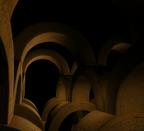 |
|||||||||
|
|
||||||||||||||||||
|
|
| Want to leave us a comment about the site or in general? Click here to access the form. |
 |
|
"The Labyrinth" by: Ben Procter Added on: Sat Aug 12 2000 |
|
| Page: 1 2 3 4 5 | |
Lighting (cont.) Note that the purest way to do multipass lighting would be to render out all of your lights as full-intensity white and apply color and dimming to each one only in the composite, but I didn't do it this way for no real reason.   Figure.6 and Figure.7 Sky light was simulated with a simple arrangement of four shadowless directional lights spaced 90 degrees apart, pointing downward at a 45 degree angle (Figure 8). This is a technique I read was used for Riven, and it's not a bad solution for general sky lighting that renders quickly. The only problem is the lack of diffuse shadowing, but this I would solve in the compositing stage.  Figure.8 My original bouncelighting was based on another Riven trick, which is to add a shadowless directional light pointing straight back at the sun source. This produced a composite render (Figure9) which was appropriately warm but too diffuse and unfocused. (My thanks to the talented Eric Hanson, who saw my first lighting pass and pointed this out.) To make the bouncelighting more specific, I proceeded to add many, many shadowed area spotlights to the points in 3D space where the sun was striking a surface, both on and off camera. This added a lot of time to my test renders, but the results repaid the trouble (Figure 10). There are probably light strikes in the scene I didn't think to model, but the essential thing is to produce bounce for the strikes actually visible in the render and I think I did this.   Figure.9 and Figure.10 |
Best viewed in 1024x768 or higher,
using any modern CSS compliant browser.